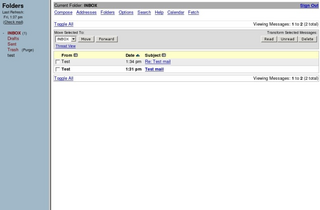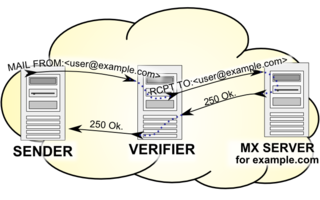Related Research Articles
The Simple Mail Transfer Protocol (SMTP) is an Internet standard communication protocol for electronic mail transmission. Mail servers and other message transfer agents use SMTP to send and receive mail messages. User-level email clients typically use SMTP only for sending messages to a mail server for relaying, and typically submit outgoing email to the mail server on port 587 or 465 per RFC 8314. For retrieving messages, IMAP is standard, but proprietary servers also often implement proprietary protocols, e.g., Exchange ActiveSync.
A mail exchanger record specifies the mail server responsible for accepting email messages on behalf of a domain name. It is a resource record in the Domain Name System (DNS). It is possible to configure several MX records, typically pointing to an array of mail servers for load balancing and redundancy.
An email address identifies an email box to which messages are delivered. While early messaging systems used a variety of formats for addressing, today, email addresses follow a set of specific rules originally standardized by the Internet Engineering Task Force (IETF) in the 1980s, and updated by RFC 5322 and 6854. The term email address in this article refers to just the addr-spec in Section 3.4 of RFC 5322. The RFC defines address more broadly as either a mailbox or group. A mailbox value can be either a name-addr, which contains a display-name and addr-spec, or the more common addr-spec alone.
Greylisting is a method of defending e-mail users against spam. A mail transfer agent (MTA) using greylisting will "temporarily reject" any email from a sender it does not recognize. If the mail is legitimate, the originating server will try again after a delay, and if sufficient time has elapsed, the email will be accepted.

SquirrelMail is a project that aims to provide both a web-based email client and a proxy server for the IMAP protocol.

Postfix is a free and open-source mail transfer agent (MTA) that routes and delivers electronic mail.
Variable envelope return path (VERP) is a technique used by some electronic mailing list software to enable automatic detection and removal of undeliverable e-mail addresses. It works by using a different return path for each recipient of a message.

Zimbra Collaboration, formerly known as the Zimbra Collaboration Suite (ZCS) before 2019, is a collaborative software suite that includes an email server and a web client.
The comparison of mail servers covers mail transfer agents (MTAs), mail delivery agents, and other computer software that provide e-mail services.

Callback verification, also known as callout verification or Sender Address Verification, is a technique used by SMTP software in order to validate e-mail addresses. The most common target of verification is the sender address from the message envelope. It is mostly used as an anti-spam measure.
Bynari is a defunct company based in Dallas, developing server and email software, mainly known for its Insight Family, similar to Microsoft Exchange Server with Outlook.
Sun Java System Communications Suite is a collection of "Industrial-Strength" software services from Sun Microsystems. The supported platforms are: Red Hat Enterprise Linux, Solaris and Windows Server. Since Oracle acquired Sun in 2010, collection is now called Oracle Communications Unified Communications Suite.
Backscatter is incorrectly automated bounce messages sent by mail servers, typically as a side effect of incoming spam.
Oracle Beehive is collaboration platform software developed by Oracle Corporation that combines email, team collaboration, instant messaging, and conferencing in a single solution. It can be deployed on-premises as licensed software or subscribed to as software-as-a-service (SaaS).

An e-mail agent is a program that is part of the e-mail infrastructure, from composition by sender, to transfer across the network, to viewing by recipient. The best-known are message user agents and message transfer agents, but finer divisions exist.
Ipswitch IMail Server is an email server application with groupware functionality that runs on Microsoft Windows OS. It was developed in 1994 by Ipswitch, Inc., a software company based in Lexington, Massachusetts.

IceWarp Mail Server is a business Email and Collaboration server developed by IceWarp Ltd. It features email with custom domain, shared calendars, documents editing, messaging and advanced tool for team collaboration and can be run in Cloud or on a local server using either Windows or Linux, or together with another solution in Hybrid deployment. In 2006 was known as Merak Mail Server.
MailEnable is a Windows-based, commercial email server distributed by MailEnable Pty. Ltd, an Australian-based software company which was established in 2002.
MDaemon Email Server is an email server application with groupware functions for Microsoft Windows, first released by Alt-N Technologies in 1996.
b1gMail is an e-mail system developed mainly in PHP. In contrast to other webmailers, b1gMail is designed to offer visitors e-mail address. It comes with own storage system and can also run on a web space with PHP and MySQL. The source code has been freely available under the GPLv2 license since 2022.
References
- 1 2 "Mail (MX) Server Survey". Security Space. Ontario, Canada: E-Soft Inc. 1 December 2023. Retrieved 19 December 2023.
- ↑ "SMTP server (MTA) written in Go".
- ↑ "Proxmox Mail Gateway". Proxmox. Retrieved 2021-07-04.
- ↑ "Information Protection". Proofpoint. Retrieved 2017-08-30.
- ↑ "docker-mailserver github". GitHub .
- ↑ "iRedMail - Free, Open Source Mail Server Solution". iredmail.org.
- ↑ "Composable all-in-one mail server written in Go".
- ↑ "mailcow: dockerized - Blog". mailcow: dockerized - Blog.
- ↑ "Mailu - Insular email distribution as container images".
- ↑ Nguyen, Antoine. "Modoboa". Modoboa.
- ↑ "A fully featured open source mail delivery platform for incoming & outgoing e-mail written in Ruby". GitHub .
- ↑ "Poste.io".
Notes
- ↑ The following server types are mentioned in the Mail (MX) Server Survey but are not represented here - ArGoSoft, GroupWise, InterScan VirusWall, MagicMail, MessageWall, ModusMail, Neon Mail Server, OpenVMS, Post.Office, Trend Micro, VisNetic.
- 1 2 3 4 5 6 7 8 9 10 11 12 13 14 15 16 17 18 19 20 21 22 23 24 mentioned in Mail (MX) Server Survey 2023
- ↑ uses ESMTP protocol